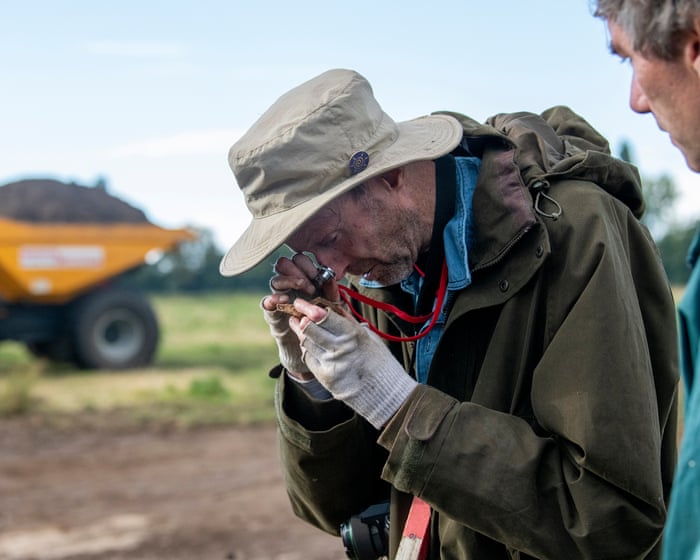If you looked out over a green field and spotted a yellow excavator tearing up the turf, you might think it was just another housing development. But the two circular patches of dark soil on this Norfolk pasture are actually “ghost ponds” being revived through an innovative and affordable form of ecological restoration.
“It looks terrible right now. People might say, ‘What have they done? It’s a disaster!'” says Carl Sayer, a geography professor at UCL, who is practically dancing with excitement around the freshly dug, barren-looking hole. “But the recovery is incredibly fast. Within a year, it’s filled with water plants. In two years, it looks like it’s always been there. It’s a spectacular comeback—you’re truly bringing back ancient plant communities.”
The two ponds being restored on this farmland are the 25th and 26th ice age ponds revived by Sayer’s team of academics, volunteers, and an enthusiastic excavator operator in the Brecks—a region known for its ancient ponds and “pingos,” formed by melting ice over 10,000 years ago.
Over the last two centuries, thousands of these ponds were filled in as land was drained and converted for agriculture.
So far, most of the 26 restored ponds have been on land purchased by the Norfolk Wildlife Trust, with funding from the National Lottery Heritage Fund’s Brecks Fen Edge and Rivers partnership. But these latest two are thanks to a local farmer, part of a growing number of private landowners reviving “ghost” and “zombie” ponds.
Recent surveys by Sayer’s team show that 22 of the ponds restored since 2022 now support 136 species of wetland plants. That’s 70% of the wetland flora found in over 400 ponds at Thompson Common, an internationally significant nature reserve in Norfolk where ponds have survived since the ice age.
The restored ponds even host rare species no longer found in existing ponds, like various-leaved pondweed, which grows in only one other location in Norfolk.
The key, Sayer explains, is a distinct layer of dark soil his team carefully uncovers. This peat-like sediment is the ancient pond bottom, built up over centuries from decaying water plants, and it’s still packed with seeds.
“It’s a perfect time capsule,” says Sayer. “It’s dark, moist, cool, and oxygen-free. This is nature’s emergency recovery system. We’ve messed up so much, but this can still bring these ecosystems back.”
Hayley McMechan, one of the researchers, is running germination trials for her PhD. Sediment samples of various ages from these ghost ponds are being monitored in tanks at Kew Gardens’ seed bank in Wakehurst. Some seeds over 1,000 years old may still sprout.
“It shows how resilient nature is—that seeds have evolved to last that long,” says McMechan. “This isn’t rewilding or restoration—it’s resurrection. To recreate a woodland, you have to plan and plant trees yourself. Here, you can’t go wrong. It’s all ready to go, like an instant cake mix—just add water.”
The process begins with Prof Helene Burningham, Sayer’s colleague at UCL, studying old maps. Many small ponds were left off maps, but old field names sometimes give clues. Lidar (light detection and ranging) is also used to find depressions in the land, and satellite imagery can reveal former pond sites, which often show up as green circles due to higher moisture levels.During dry summers like this one, the team begins by using an auger to drill down and confirm the bottom of the ghost pond. This layer is identified by white fragments of pond snail shells, which have a more pointed spiral than land snails.
Next, a straight trench is dug to locate the deepest sediment, revealing the pond’s center. “The middle is never where you expect it to be, but careful digging will find the center, and then you work outward from there,” says Sayer.
A second trench is dug across the first, forming a cross shape, which helps pinpoint the pond’s exact dimensions.
Then, the digger takes over, carefully shaping the pond’s gently sloping natural edges—avoiding steps or shelves—and being cautious not to dig below the seed layer. “When we reach the right level, we can leave it to Dale, the digger driver,” Sayer adds. “He’s truly brilliant.”
A team member uncovers pottery from the former pond’s base, speculated to be either Roman or medieval in origin.
Digging out a pond takes a full day, but Dale Garnham “absolutely loves” this unusual task. “This is my favorite kind of work; I just hope it really takes off. On a building site, you dig a hole, put a pipe in, and cover it up. It’s nice to come back here and see what you’ve done and how it progresses.”
As Garnham skillfully removes the topsoil, volunteers uncover treasures below. Dan Hoare finds a pristine banded river snail shell, likely from Roman times. Another volunteer identifies a piece of Roman pottery and late Neolithic “pot boilers”—charred flints once used to heat water. “Wetlands were places where people needed to be,” Sayer notes.
The only unwelcome discovery is an old section of plastic drain, installed during 1980s agricultural improvements. The digger will break it up. “Any pipes we find are smashed. We don’t want water draining away, but we also don’t want water draining in,” Sayer explains.
Once the ponds fill naturally with clean rainwater, they are quickly colonized. Some skeptics suggest the plants come from waterbirds rather than ancient seeds, but Sayer points to the unique rare plants and sheer quantity of new growth in the restored ponds—none of which are found nearby. “All this can’t come in so fast on a duck’s bottom,” he says.
Even without connections to other waterways, the ninespine stickleback fish has rapidly returned to the ghost ponds. “We’ve no idea how it got there. There’s no biological mechanism that would allow it without a hydrological connection,” Sayer remarks. Could solving that mystery be another PhD project? “We want a few puzzles like this. It keeps me in a job,” he jokes.
According to Sayer, pond restoration offers a significant boost to nature at a modest cost—far less than restoring a meadow or ancient woodland. He and his volunteers can excavate a pond in a day for about £2,000, with the main expenses being digger and dumper hire, plus a skilled driver.
“Landowners are keen to do it—the only barrier is funding,” Sayer says. “Millions go into river restoration, but they’re hard to fix. Restoring a pond has a small footprint and a massive impact. So many wetlands have been filled in. You could take what we’re doing here and spread it everywhere.
“I’ll never be involved in anything so important. It’s the ecological restoration you dream of.”
Frequently Asked Questions
Of course Here is a list of helpful and clear FAQs about the topic of ancient seed resurrection from Englands ghost ponds
General Beginner Questions
Q What are ghost ponds
A They are old farm ponds that were deliberately filled in with soil and plowed over for agriculture often centuries ago making them ghost features in the landscape
Q What is the resurrection referring to
A It refers to the process of scientists finding and germinating ancient seeds that have been preserved for over 1000 years in the mud of these ghost ponds
Q How can seeds be 1000 years old and still grow
A The seeds were buried in cold wet and oxygenpoor mud at the bottom of the ponds This environment acts like a natural refrigerator putting them in a state of suspended animation and preventing them from rotting
Q Where is this happening
A The project is focused on ghost ponds being rediscovered and restored across the English countryside
Q What kinds of plants are they hoping to grow
A They are typically native aquatic and wetland plants that would have grown around the ponds before they were filled in some of which may now be rare or locally extinct
Process Science Questions
Q How do scientists find these ancient ghost ponds
A They use a combination of old maps historical records and aerial photography to locate the outlines of ponds that are no longer visible on the ground
Q How do they get the seeds out
A Researchers take core samples of the pond sediment much like taking a core sample of ice from a glacier They then carefully search through the different layers of mud for preserved seeds
Q How do they know how old the seeds are
A They use a technique called radiocarbon dating This measures the decay of a specific type of carbon in the seed to accurately determine its age
Q Do they just plant the seeds in dirt
A Not exactly Scientists often simulate the ponds original conditions in a lab placing the seeds in water or wet soil with the right temperature and light to encourage them to sprout
Q Whats the success rate for getting these ancient seeds to grow
A It varies but its often surprisingly high for seeds preserved in ideal waterlogged




